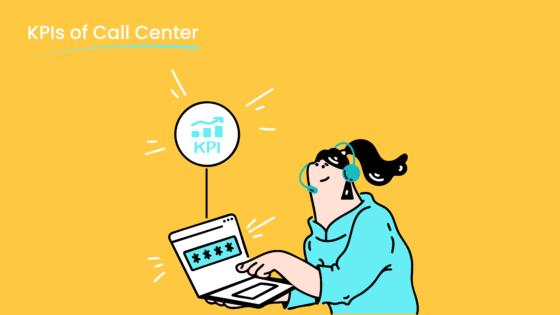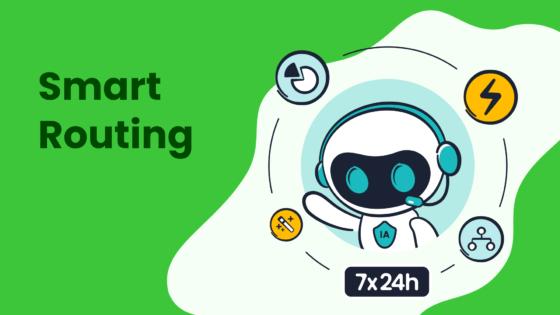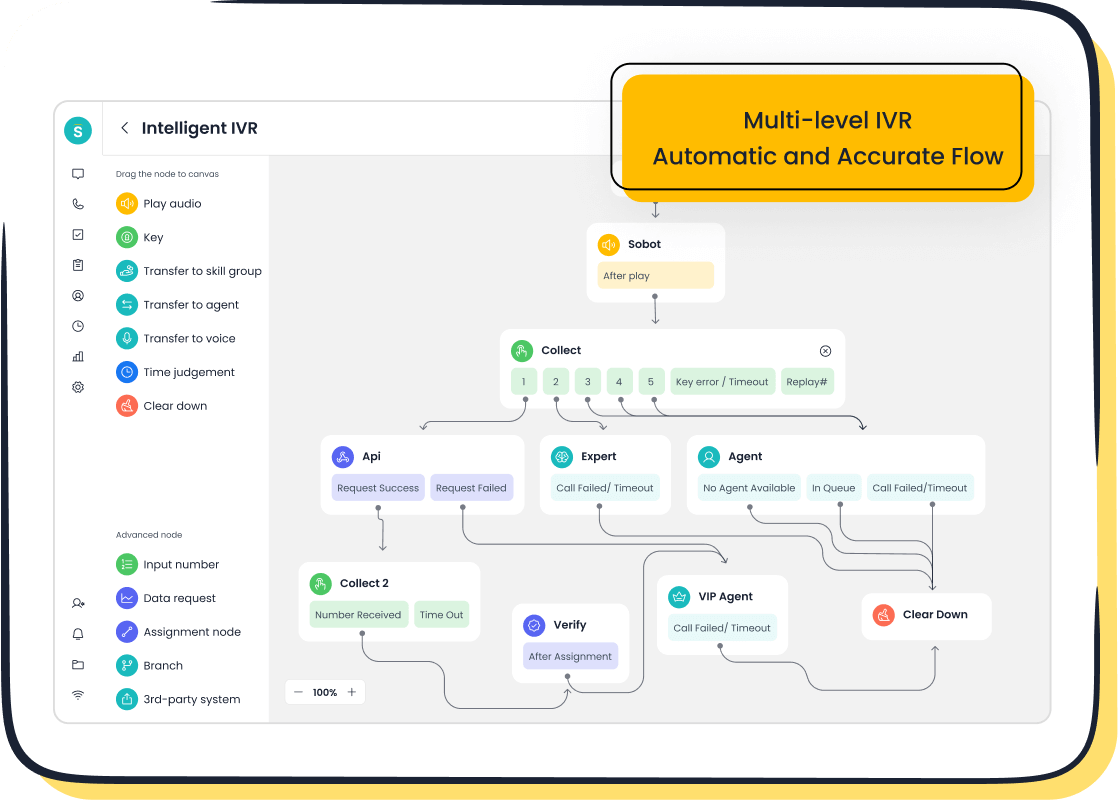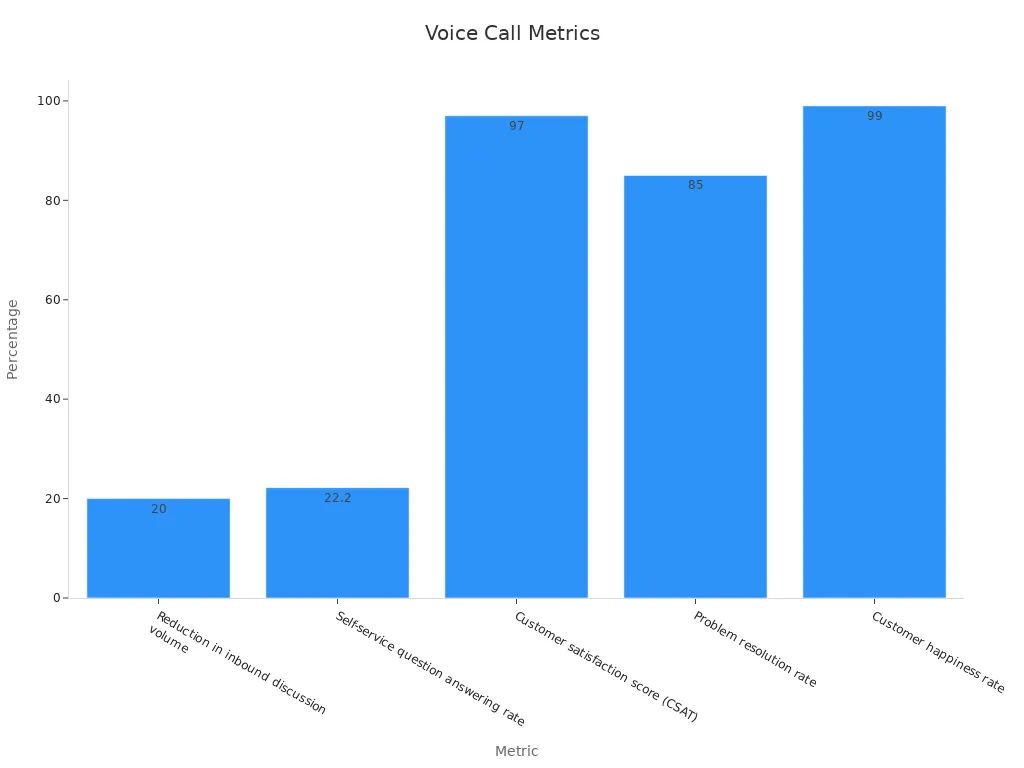Top Metrics for Contact Center Success in 2025


Metrics are the backbone of success in modern contact centers. They help you measure performance, identify gaps, and make improvements. In 2025, their role becomes even more crucial as customer expectations soar and digital interactions grow by 50% compared to 2020. Without robust metrics, businesses risk losing $75 billion annually due to poor service. Aligning contact center performance metrics with evolving technologies and customer needs ensures you stay competitive. Tools like Sobot empower you to track key data, reduce costs, and achieve operational excellence.
Understanding Contact Center Performance Metrics
What Are Contact Center Metrics?
Contact center metrics are measurable indicators that help you evaluate the performance of your customer service operations. These metrics provide insights into how well your team handles customer interactions and identifies areas for improvement. Common examples include answer rates, first call resolution, and customer satisfaction scores. By tracking these, you can ensure your contact center meets customer expectations and business goals.
Modern tools, like predictive analytics, allow you to anticipate customer needs. Automated workflows streamline repetitive tasks, improving efficiency. Self-service portals also play a role by enabling customers to resolve issues independently, which enhances overall service effectiveness. When you use these metrics effectively, you gain a clear picture of your contact center's strengths and weaknesses.
Why Metrics Are Critical for Contact Center Success
Metrics are essential for driving success in your contact center. They help you measure performance, identify gaps, and implement improvements. Studies show that 95% of companies believe tracking metrics is crucial for enhancing customer satisfaction. Key metrics like first call resolution and call abandonment rates directly impact customer experience and operational efficiency.
Real-time dashboards and scheduled reports keep your team informed. These tools allow you to make quick adjustments during peak times, ensuring consistent service quality. By continuously monitoring metrics, you can adapt to changing customer needs and maintain a competitive edge.
The Role of Metrics in Driving Continuous Improvement
Metrics are not just about tracking performance; they are a foundation for continuous improvement. For example, analyzing customer feedback can help you identify patterns and reduce repeat calls. Efficiency analysis has been shown to decrease average handle time by 40%, while speech analytics can lead to cost savings of up to 30%.
| Key Performance Indicator | Improvement Achieved |
|---|---|
| Customer Satisfaction | Improved through analytics tracking |
| First Call Resolution | Reduced repeat calls by identifying patterns |
| Average Handle Time | Decreased by 40% through efficiency analysis |
| Net Promoter Score | Enhanced by evaluating customer sentiment |
By leveraging these insights, you can refine your processes, improve customer satisfaction, and achieve measurable performance gains. Metrics empower you to make data-driven decisions that benefit both your customers and your business.
Key Metrics for Customer Experience in 2025

Customer Satisfaction Score (CSAT) and Its Importance
Customer Satisfaction Score (CSAT) is one of the most critical metrics for measuring how happy your customers are with your service. It directly reflects the quality of your customer experience. CSAT is typically measured by asking customers to rate their satisfaction on a scale of 1 to 5 after an interaction. A higher score indicates better service quality.
Why does CSAT matter? Studies show that a 1% increase in CSAT can boost your company’s revenue by 4-5%. This metric also helps you identify areas where your service needs improvement. For instance, if your CSAT score falls below 70%, it signals the need for immediate action to enhance your customer experience. Companies with scores above 82% are considered leaders in customer satisfaction and loyalty.
| CSAT Score Range | Implication | Action Required |
|---|---|---|
| Below 70% | Indicates need for improvement | Immediate action needed |
| 70% - 82% | Neutral zone | Monitor closely |
| Above 82% | Good performance | Maintain and enhance service |

Sobot’s Voice/Call Center can help you improve your CSAT by providing tools like real-time monitoring and AI-powered Voicebots. These features allow you to address customer concerns quickly and efficiently, ensuring a seamless experience.
Net Promoter Score (NPS) for Measuring Loyalty
Net Promoter Score (NPS) is a powerful metric for gauging customer loyalty. It measures how likely your customers are to recommend your business to others. NPS categorizes customers into three groups: Promoters (scores 9-10), Passives (scores 7-8), and Detractors (scores 0-6). Promoters are your most loyal customers, while Detractors may harm your brand reputation.
Why is NPS important? Companies leading in customer experience often achieve twice the revenue growth of their competitors. Additionally, customers with excellent past experiences spend 140% more than those with poor experiences. By improving your NPS, you can strengthen customer loyalty and drive long-term growth.
Sobot’s solutions, such as smart call routing and workflow automation, can enhance your NPS by ensuring that customers receive personalized and efficient service. These tools help you turn Passives into Promoters and reduce the number of Detractors.
First Call Resolution (FCR) and Its Impact on Satisfaction
First Call Resolution (FCR) measures your ability to resolve customer issues during the first interaction. It is a key driver of customer satisfaction and loyalty. For every 1% improvement in FCR, customer satisfaction increases by 1%. Moreover, 95% of customers are more likely to stay with a company that resolves their issues on the first call.

Improving FCR reduces the need for follow-up calls, saving time for both your agents and customers. It also enhances the overall customer experience by minimizing frustration. Tools like Sobot’s AI-powered Voicebot and intelligent IVR can significantly boost your first contact resolution rate. These features ensure that customers are directed to the right agent or provided with self-service options, leading to quicker issue resolution.
| Metric | Impact on Customer Experience Improvements |
|---|---|
| First Response Time (FRT) | Optimizing this metric improves overall customer satisfaction (CSAT) scores. |
| Average Resolution Time (ART) | A reduction in ART increases CSAT scores and reduces Customer Effort Score (CES), enhancing customer confidence and NPS. |
| Customer Satisfaction Score (CSAT) | An increase of 1% in CSAT scores can lead to an increase of 4-5% in the company’s overall revenue. |
By focusing on FCR, you can build trust and loyalty among your customers. Sobot’s advanced analytics and real-time monitoring tools provide actionable insights to help you achieve this goal.
Average Handle Time (AHT) and Customer Experience Insights
Average handle time (AHT) is a critical metric for understanding the efficiency of your contact center operations. It measures the total time an agent spends on a customer interaction, including talk time, hold time, and after-call work. A lower AHT often indicates faster service, but it must be balanced with quality to ensure customer satisfaction.
Reducing AHT can significantly impact your contact center's performance. For example:
- Cutting AHT by just 10 seconds per call can save 2,700 hours in labor costs for every 100,000 calls.
- Companies like IAG have reduced call handle times by 20% and call volume by 18% by introducing self-service options.
- PlumChoice decreased AHT by 64 seconds by focusing on first call resolution and customer satisfaction, proving that effective handling improves customer experience.
While reducing AHT is beneficial, you must avoid sacrificing quality for speed. Customers value quick resolutions, but they also expect personalized and empathetic service. Striking the right balance ensures that your agents resolve issues efficiently without leaving customers feeling rushed or undervalued.
Tools like Sobot’s Voice/Call Center can help you optimize AHT without compromising service quality. Features such as intelligent IVR and AI-powered Voicebots streamline call routing and automate repetitive tasks. These tools reduce the time agents spend on manual processes, allowing them to focus on resolving customer issues effectively. Additionally, real-time monitoring and analytics provide insights into agent performance, helping you identify areas for improvement.
To improve AHT, consider these actionable strategies:
- Leverage AI and automation: Use AI-powered tools to handle routine inquiries, freeing up agents for more complex tasks.
- Provide comprehensive training: Equip your agents with the skills and knowledge they need to resolve issues quickly and accurately.
- Streamline workflows: Simplify processes to minimize after-call work and reduce hold times.
- Monitor and analyze data: Use analytics to identify bottlenecks and implement targeted improvements.
By focusing on these strategies, you can enhance both efficiency and customer satisfaction. Remember, AHT is not just about speed—it’s about delivering a seamless and positive experience for your customers.
Evaluating Call Center Agent Performance
Metrics for Measuring Call Center Agent Performance
Tracking the right metrics is essential for evaluating call center agent performance. These metrics provide a clear picture of how well your agents handle customer interactions and meet service goals. By focusing on measurable indicators, you can identify strengths, address weaknesses, and drive continuous improvement.
Here are some of the most impactful agent performance metrics:
- First Call Resolution (FCR): Measures how often agents resolve customer issues during the first interaction. Higher FCR rates lead to better customer retention and satisfaction.
- Average Handle Time (AHT): Tracks the time agents spend on each interaction. Lower AHT often reflects higher efficiency but must be balanced with quality.
- Customer Satisfaction (CSAT): Indicates how happy customers are after interacting with your agents. High CSAT scores reflect excellent service.
- Net Promoter Score (NPS): Gauges customer loyalty by measuring how likely customers are to recommend your business.
| Metric | Description |
|---|---|
| First Call Resolution (FCR) | Measures how often a customer issue is resolved in the first interaction, impacting customer retention. |
| Average Handle Time (AHT) | The time an agent spends with a customer; lower times generally indicate higher efficiency. |
| Customer Satisfaction (CSAT) | Indicates overall customer happiness post-interaction, crucial for assessing agent performance. |
| Net Promoter Score (NPS) | Gauges customer loyalty and likelihood to recommend the service, reflecting agent effectiveness. |
Focusing on these metrics helps you create a high-performing team. Tools like Sobot’s Voice/Call Center provide real-time analytics and monitoring, enabling you to track these metrics effectively and make data-driven decisions.
Quality Assurance (QA) Scores and Their Role
Quality Assurance (QA) scores play a vital role in maintaining high standards in your contact center. These scores evaluate how well agents adhere to company policies, scripts, and customer service best practices. QA programs ensure consistency and help identify areas for improvement.
A robust QA framework includes:
- Clear, Quantifiable Metrics: Setting specific benchmarks simplifies expectations for agents.
- Streamlined Documentation Process: Providing agents with a checklist improves efficiency and reduces errors.
- Reduction in Workload: Automating QA processes allows agents to focus on delivering exceptional service.
- Increased Confidence in Data Management: Reliable QA systems build trust in your operational data.
For example, companies like Homebot have successfully implemented QA scorecards to enhance agent performance. These tools not only improve service quality but also boost agent confidence and job satisfaction. When agents know what is expected of them, they perform better and feel more engaged.
Sobot’s Voice/Call Center offers advanced QA tools, such as call recording and transcription, to help you evaluate agent interactions. These features allow you to provide targeted feedback and coaching, ensuring continuous improvement in agent performance.
Average Response Time and Agent Efficiency
Average response time is a critical metric for measuring agent efficiency. It tracks how quickly agents respond to customer inquiries, directly impacting customer satisfaction and resolution rates. Faster response times create a positive customer experience and reduce frustration.
Key metrics related to response time include:
- Average Handle Time (AHT): Shorter AHT indicates quicker issue resolution, improving efficiency.
- Average First Response Time (AFRT): Measures the time taken to respond to a customer’s initial inquiry. Lower AFRT enhances customer satisfaction.
- Average Hold Time: Tracks how long customers wait on hold. Reducing hold times improves the overall experience.
- Service Level Rate: Reflects the percentage of calls answered within a predefined time frame. Meeting these targets ensures responsiveness.
- Customer Effort Score (CES): Indicates how easy it is for customers to resolve their issues. Lower CES scores reflect smoother interactions.
| Metric | Description | Impact on Efficiency |
|---|---|---|
| Average Handle Time (AHT) | Measures the average duration of a customer interaction. | Lower AHT indicates higher efficiency in resolving customer issues. |
| Average First Response Time | Time taken to respond to a customer's initial inquiry. | Lower AFRT leads to better customer experiences and higher resolution rates. |
| Average Hold Time | Duration a customer spends on hold during an interaction. | Shorter hold times signify quicker issue resolution, enhancing agent efficiency. |
| Service Level Rate | Percentage of calls answered within a predefined time frame. | Meeting service level targets improves responsiveness and overall customer satisfaction. |
| Customer Effort Score (CES) | Measures how easy it is for customers to resolve their issues. | Lower CES indicates smoother interactions, which can lead to increased agent efficiency. |
Studies show that reducing response times not only improves customer satisfaction but also boosts agent morale. Agents who can resolve issues quickly feel more accomplished and less stressed. This positive cycle enhances overall call center agent performance.
Sobot’s intelligent tools, such as smart call routing and AI-powered Voicebots, help you optimize response times. These features ensure that customers are connected to the right agent or self-service option, reducing delays and improving efficiency.
Agent Engagement and Retention Metrics
Agent engagement plays a pivotal role in the success of your contact center. When agents feel motivated and valued, they perform better, resolve issues faster, and create positive customer experiences. Retention metrics help you measure how well your contact center supports and retains its workforce. Together, these metrics provide a clear picture of your team's morale and effectiveness.
Why Agent Engagement Matters
Engaged agents are the backbone of a thriving contact center. They approach their work with enthusiasm, which directly impacts customer satisfaction and operational efficiency. Studies show that engaged agents are more committed to resolving customer issues and retaining customers. They feel empowered and capable, which translates into higher first call resolution (FCR) rates and better call quality scores.
However, engagement levels in the industry reveal room for improvement:
- Only 27% of Customer Service Representatives (CSRs) are highly engaged.
- 10% are engaged, while 57% remain indifferent, and 5% are highly disengaged.
These statistics highlight the need for strategies that boost engagement and reduce indifference. By focusing on engagement, you can transform your contact center into a high-performing environment.
Key Metrics for Measuring Engagement and Retention
Tracking the right metrics helps you understand how engaged your agents are and how likely they are to stay with your organization. Here are some essential metrics to monitor:
- Overall Satisfaction: Measures how content agents feel in their roles. High satisfaction levels indicate a positive work environment.
- Willingness to Continue Working: Reflects agents' commitment to staying with your company. A high score here signals strong retention potential.
- Willingness to Recommend: Gauges whether agents would recommend your contact center as a great place to work. This metric often correlates with high morale and engagement.
| Metric | What It Measures | Why It Matters |
|---|---|---|
| Overall Satisfaction | Agent happiness in their role | Indicates workplace morale |
| Willingness to Continue | Commitment to staying with the organization | Predicts retention rates |
| Willingness to Recommend | Likelihood of recommending the workplace | Reflects agent pride and engagement levels |
By monitoring these metrics, you can identify areas for improvement and implement targeted strategies to enhance engagement.
Strategies to Boost Agent Engagement and Retention
Improving engagement requires a proactive approach. Here are some actionable strategies to consider:
- Provide Regular Feedback: Offer constructive feedback to help agents grow. Recognize their achievements to boost morale.
- Invest in Training and Development: Equip agents with the skills they need to succeed. Continuous learning opportunities foster a sense of value and purpose.
- Foster a Positive Work Environment: Create a culture of respect and collaboration. Encourage open communication and celebrate team successes.
- Leverage Technology: Use tools like Sobot’s Voice/Call Center to streamline workflows and reduce repetitive tasks. This allows agents to focus on meaningful interactions, increasing job satisfaction.
Tip: Engaged agents not only perform better but also contribute to a more positive customer experience. By prioritizing their well-being, you create a win-win situation for your team and your customers.
The Link Between Engagement and Customer Satisfaction
Engaged agents drive better customer outcomes. High engagement levels correlate with improved FCR rates and higher customer satisfaction scores. When agents feel supported and empowered, they handle customer interactions with confidence and empathy. This creates a ripple effect, enhancing both customer loyalty and your contact center's reputation.
By focusing on agent engagement and retention metrics, you can build a resilient and motivated team. Tools like Sobot’s Voice/Call Center provide real-time insights into these metrics, helping you make data-driven decisions that benefit your agents and your business.
Metrics for Operational Efficiency in Contact Centers

Cost Per Contact and Budget Optimization
Cost per contact is a vital metric for evaluating the financial efficiency of your contact center. It measures the average cost incurred for handling each customer interaction, including expenses related to staffing, technology, and infrastructure. Lowering this metric can lead to significant budgetary savings while maintaining high customer service performance.
Optimizing workflows and integrating AI-powered tools can reduce operational costs by up to 31%. For example, digital process transformation has been shown to increase revenue per employee by 42%. Workflow optimization metrics also reveal that mid-sized banks save an average of $12.5 million annually by reducing transaction processing costs.
To improve cost per contact, focus on automating repetitive tasks and streamlining processes. Tools like Sobot’s Voice/Call Center offer features such as intelligent IVR and AI-powered Voicebots, which enhance efficiency and reduce costs. By leveraging these technologies, you can achieve a 15-25% increase in operational productivity and a 14% improvement in profit margins.
Service Level and Abandonment Rate
Service level measures the percentage of calls answered within a predefined time frame, while the call abandonment rate tracks the percentage of customers who hang up before speaking to an agent. Together, these metrics reflect the responsiveness and reliability of your contact center.
Industry standards recommend answering 80% of calls within 20 seconds and maintaining a call abandonment rate below 5%. However, the average incoming call abandonment rate in 2021 was 6.44%, highlighting room for improvement.
| Metric | Value |
|---|---|
| Service Level Standard | 80% of calls in 20 seconds |
| Call Abandon Rate Standard | 6% (Good if < 5%) |
| Average Incoming Call Abandon Rate | 6.44% (2021) |
Reducing abandonment rates requires proactive strategies. Use tools like Sobot’s smart call routing to connect customers to the right agent quickly. Real-time monitoring also helps you identify bottlenecks and adjust staffing during peak times. By improving service levels, you can enhance customer service performance and reduce frustration.
Call Volume and Forecast Accuracy
Understanding call volume trends and improving forecast accuracy are essential for managing unpredictable surges and optimizing workforce allocation. AI-powered call prediction tools can analyze historical data to identify patterns and improve forecasting accuracy.
- AI call prediction enhances staffing decisions and improves customer experiences.
- Analyzing past call records reveals significant patterns and trends.
- Strategic resource allocation reduces inefficiencies during high-demand periods.
By integrating forecasting models into your existing systems, you can adapt to changing demands with agility. Sobot’s Voice/Call Center provides real-time analytics and data collection tools, enabling you to make informed decisions and improve operational efficiency.
Accurate forecasting not only enhances customer service performance but also reduces costs associated with overstaffing or understaffing. This balance ensures your contact center operates efficiently while delivering exceptional service.
Utilization Rate and Workforce Optimization
Utilization rate is a critical metric for understanding how effectively your contact center uses its workforce. It measures the percentage of time agents spend actively handling customer interactions compared to their total available time. A high utilization rate indicates efficient use of resources, while a low rate may signal underutilization or poor workforce planning.
Tracking the agent utilization rate helps you identify inefficiencies in your operations. For example, if agents spend too much time idle, it may indicate overstaffing or uneven workload distribution. On the other hand, overworked agents with excessively high utilization rates may experience burnout, leading to lower performance and higher turnover.
To optimize your workforce, focus on balancing workloads and improving scheduling accuracy. Use historical data and AI-powered forecasting tools to predict call volumes and allocate resources effectively. This ensures that agents remain engaged without feeling overwhelmed. Additionally, consider cross-training your team to handle multiple types of inquiries. This flexibility allows you to adapt to changing customer demands and maintain a steady agent utilization rate.

Sobot’s Voice/Call Center offers tools like real-time monitoring and smart call routing to help you manage your workforce efficiently. These features ensure that calls are distributed evenly among agents, reducing idle time and improving overall productivity. By leveraging these tools, you can achieve a balanced agent utilization rate that supports both operational efficiency and employee satisfaction.
Tip: Regularly review your utilization metrics to identify trends and make data-driven adjustments. A well-optimized workforce not only improves efficiency but also enhances the customer experience.
Leveraging Sobot's Voice/Call Center for Metric Tracking
Real-Time Monitoring and Analysis with Sobot
Real-time monitoring is essential for maintaining high performance in your contact center. Sobot's Voice/Call Center provides advanced tools that allow you to track key metrics as they happen. This feature helps you identify issues immediately, enabling quick adjustments to improve customer satisfaction and operational efficiency.
For example, real-time monitoring can reveal bottlenecks in your support workflow. By addressing these issues promptly, you can reduce inbound discussion volume by 20% and increase positive feedback to over 96%. Sobot's analytics tools also provide insights into customer behavior, helping you optimize processes and enhance service quality.
| Metric Description | Value |
|---|---|
| Reduction in inbound discussion volume | 20% |
| Increase in positive feedback | 96% + |
| Customer satisfaction rate | Over 95% |
| Problem resolution rate | 85% |

Sobot's real-time monitoring tools also leverage advanced natural language processing (NLP) and machine learning algorithms. These technologies adapt to customer needs over time, ensuring accurate routing and improved service quality. With omnichannel support, you can deliver a seamless experience across all communication channels.
AI-Powered Voicebot for Enhanced Customer Interactions
Sobot's AI-powered Voicebot transforms customer interactions by providing intelligent, human-like responses. This tool uses advanced algorithms to recognize customer intent and deliver accurate answers. It also handles repetitive queries, freeing up agents to focus on complex issues.
Independent studies highlight the importance of well-designed AI voicebots. They show that trust in AI increases when customers perceive failures as external rather than internal. Sobot's Voicebot incorporates these insights, ensuring reliable and trustworthy interactions.
Did you know? A well-implemented AI Voicebot can achieve a self-service question answering rate of 22.2% and a customer happiness rate of 99%. These results demonstrate the potential of AI to enhance customer satisfaction and loyalty.
By integrating Sobot's Voicebot into your contact center, you can improve problem resolution rates and reduce average handle time. This leads to a more efficient operation and happier customers.
Smart Call Routing and Workflow Automation
Efficient call routing is critical for reducing wait times and improving customer satisfaction. Sobot's smart call routing system ensures that customers are connected to the right agent or department based on their needs. This feature minimizes delays and enhances the overall customer experience.
Workflow automation further streamlines operations by automating repetitive tasks. For instance, Sobot's system can prioritize and assign leads based on predefined rules, ensuring that agents focus on high-value interactions. These tools not only improve efficiency but also reduce operational costs.
| Feature | Impact on Performance |
|---|---|
| Smart Call Routing | Reduces wait times and improves customer satisfaction |
| Workflow Automation | Enhances agent productivity and operational efficiency |
| Advanced Analytics | Provides actionable insights for continuous improvement |
By leveraging Sobot's smart call routing and automation features, you can optimize your contact center's performance. These tools ensure that your team delivers exceptional service while maintaining operational efficiency.

Integration with CRM Systems for Comprehensive Insights
Integrating your contact center with Customer Relationship Management (CRM) systems unlocks powerful insights that drive better decision-making and customer service. CRM systems consolidate customer data, enabling you to access detailed profiles, purchase histories, and interaction records in one place. This integration ensures your agents have the information they need to deliver personalized and efficient service.
Benefits of CRM Integration
- Unified Customer Data: CRM systems centralize customer information, eliminating data silos. Agents can view complete customer histories, reducing repetitive questions and improving first call resolution (FCR).
- Enhanced Decision-Making: Real-time data from CRM systems helps you identify trends and customer preferences. This insight allows you to tailor your services and improve customer satisfaction scores (CSAT).
- Streamlined Workflows: Integration automates processes like ticket creation and follow-ups. This reduces average handle time (AHT) and boosts agent productivity.
Example: Companies using CRM-integrated contact centers report a 20% increase in customer retention rates and a 15% reduction in operational costs. Source
How Sobot Enhances CRM Integration
Sobot’s Voice/Call Center seamlessly integrates with popular CRM systems like Salesforce and HubSpot. This integration provides agents with a unified workspace where they can manage calls, access customer data, and track performance metrics. Features like intelligent IVR and AI-powered Voicebots further enhance workflows by automating repetitive tasks and routing calls efficiently.
| Feature | Benefit |
|---|---|
| Unified Workspace | Combines call management and CRM data for streamlined operations. |
| Intelligent IVR | Routes calls based on CRM data, ensuring faster resolutions. |
| Real-Time Analytics | Provides actionable insights for improving CSAT and NPS scores. |
By leveraging Sobot’s CRM integration, you can improve customer satisfaction, reduce costs, and optimize your contact center’s performance. This powerful combination ensures your team delivers exceptional service while staying ahead of industry trends.
Actionable Strategies for Improving Metrics
Using AI and Automation to Enhance Metric Tracking
AI and automation have revolutionized the way you approach measuring the success of your contact center. By automating repetitive tasks and leveraging AI-driven insights, you can track metrics more efficiently and accurately. For example, automated dashboards can streamline project tracking, improving visibility and reducing manual errors. This approach enhances resource utilization and shortens process cycle times.
A case study highlights the impact of AI on metric tracking:
| Metric | Before AI | After AI | Change |
|---|---|---|---|
| Manual hours reduced | N/A | N/A | Labor cost saved |
| Error rates reduced | N/A | N/A | Less rework |
| Claim processing time | 5 days | 2 days | Improved customer satisfaction |
Sobot’s AI-powered Voicebot exemplifies this transformation. It automates routine inquiries, reducing agent workload and improving first call resolution rates. By integrating AI tools, you can focus on strategic improvements while ensuring accurate metric tracking.
Real-Time Dashboards for Performance Monitoring
Real-time dashboards provide you with instant access to critical metrics, enabling faster decision-making. These dashboards allow you to monitor performance trends, identify bottlenecks, and adjust strategies on the fly. For instance, 73% of organizations report that real-time analytics are crucial for maintaining a competitive edge.
Here are some proven benefits of real-time dashboards:
- Fraud prevention: American Express prevents $2 billion in fraudulent transactions annually.
- Efficiency improvement: Advanced analytics improve efficiency by 15-20%.
- Cost reduction: Operational costs decrease by an average of 10%.
Sobot’s Voice/Call Center offers real-time monitoring tools that help you track metrics like average handle time and customer satisfaction. These insights empower you to make data-driven decisions, ensuring your contact center operates at peak efficiency.
Collecting and Analyzing Customer Feedback
Customer feedback is a goldmine for improving your contact center’s performance. By collecting and analyzing feedback, you can identify pain points and implement targeted solutions. For example, feedback analysis can reveal why certain interactions fail to meet customer expectations, helping you refine your processes.
To maximize the value of customer feedback:
- Use surveys to gather insights on customer satisfaction and loyalty.
- Analyze feedback trends to identify recurring issues.
- Implement changes based on actionable insights.
Sobot’s tools, such as AI-powered Voicebots and smart call routing, enhance your ability to act on feedback. These features ensure that customers feel heard and valued, boosting satisfaction and loyalty.
Continuous Improvement Through Data-Driven Decisions
Continuous improvement relies on actionable insights derived from data. By analyzing metrics like call volume, resolution times, and customer satisfaction scores, you can identify patterns and refine your processes. This approach ensures your contact center adapts to evolving customer needs while maintaining operational efficiency.
Data-driven strategies offer several benefits:
- Optimize staffing by forecasting call volumes accurately.
- Address recurring issues proactively, reducing inefficiencies.
- Achieve significant cost savings and improve sustainability.
For example, organizations using advanced analytics report a 5%-6% increase in productivity and profitability. AI integration further reshapes the industry by automating data analysis and uncovering hidden trends. These tools empower you to make informed decisions that enhance both customer satisfaction and agent performance.
Through data analysis, you can evaluate the financial impact of new technologies. Balancing costs against benefits like efficiency gains and improved customer experiences ensures sustainable growth. Sobot’s Voice/Call Center provides real-time analytics and AI-powered tools to help you track key metrics and implement targeted improvements. Features like intelligent IVR and smart call routing streamline workflows, enabling your team to focus on delivering exceptional service.
Tip: Use historical data to customize agent training programs. This approach improves resolution rates and aligns your team with customer expectations.
By adopting a data-driven mindset, you can transform your contact center into a hub of continuous improvement. Metrics guide your decisions, ensuring every change contributes to better outcomes for your customers and your business.
Metrics are the cornerstone of contact center success in 2025. They provide actionable insights into customer interactions, agent performance, and operational strategies. By establishing Key Performance Indicators (KPIs), you can assess performance and refine processes to meet customer expectations. Socio-emotional metrics add depth, helping you tailor training and improve service quality.
Looking Ahead: Metrics will drive innovation by leveraging AI and advanced analytics. These tools enable real-time solutions, predictive modeling, and customized success plans, ensuring your contact center adapts to evolving customer needs and achieves excellence.
By adopting tools like Sobot’s Voice/Call Center, you can stay ahead in this transformative era.
FAQ
What are the most important metrics for contact center success in 2025?
Focus on Customer Satisfaction Score (CSAT), Net Promoter Score (NPS), First Call Resolution (FCR), and Average Handle Time (AHT). These metrics measure customer happiness, loyalty, and operational efficiency. Tools like Sobot’s Voice/Call Center help you track and improve these metrics effectively.
How can Sobot’s Voice/Call Center improve my contact center’s performance?
Sobot’s Voice/Call Center offers real-time monitoring, AI-powered Voicebots, and smart call routing. These features reduce response times, improve first call resolution, and enhance customer satisfaction. Integration with CRM systems provides comprehensive insights, helping you optimize workflows and agent performance.
Why is First Call Resolution (FCR) so important?
FCR directly impacts customer satisfaction and loyalty. Resolving issues on the first call saves time for both customers and agents. Studies show that a 1% improvement in FCR increases customer satisfaction by 1%. Sobot’s intelligent tools help you achieve higher FCR rates.
How does AI improve contact center efficiency?
AI automates repetitive tasks, analyzes customer data, and provides actionable insights. It reduces average handle time and improves first call resolution. Sobot’s AI-powered Voicebot enhances customer interactions by recognizing intent and delivering accurate responses, freeing agents to handle complex issues.
Can Sobot’s solutions integrate with my existing systems?
Yes, Sobot’s Voice/Call Center integrates seamlessly with popular CRM systems like Salesforce and HubSpot. This integration centralizes customer data, streamlines workflows, and improves decision-making. It ensures your agents have the tools they need to deliver personalized and efficient service.
See Also
Discovering Leading Cloud Contact Centers for the Year 2025
Best Reviewed Contact Center Solutions for the Year 2024
Leading Cloud Contact Center Services Evaluated for 2024
Best 10 Analytics Software for Call Centers in 2024
Ten Essential Steps for Implementing Omnichannel Contact Centers
